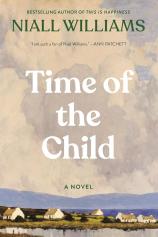Time of the Child
Review
Time of the Child
Anyone enchanted by the village of Faha, which appears in Niall Williams’ novels HISTORY OF THE RAIN and THIS IS HAPPINESS, will be pleased by his decision to return to that locale in western Ireland’s County Clare for his latest book, TIME OF THE CHILD. In the hands of a lesser writer, the story of what happens when a foundling enters the lives of the village doctor and his unmarried daughter at Christmas time would risk straying into maudlin territory. But that’s not a problem in this quietly resonant novel.
In Williams’ capable telling, it’s a mature, deeply moving story that touches on the inevitability of change in even the most static places, moral choices and their sometimes unintended consequences, and even the first stirrings of feminist sensibility in a society dominated by the Catholic Church. The fact that it features one lovely, meticulously crafted sentence after another is a delightful bonus.
"TIME OF THE CHILD is a novel that invites slow reading as one effortlessly slips into the idiosyncratic, seemingly eternal rhythm of small-town Irish life.... Williams’ writing about Faha and its inhabitants sidesteps cliché and brims with rich sensory detail."
TIME OF THE CHILD begins on the first Sunday of Advent in 1962, only four years after electricity has arrived in this “sinking parish on the furthermost edge of nowhere.” At the heart of the story are widower Dr. Jack Troy, successor to his father as the village’s general practitioner, who treats patients out of his home (when he’s not making house calls across the countryside), and Ronnie, the eldest of his three daughters. She is unmarried as she approaches her 30th birthday and is more interested in reading and writing than she is in finding a mate.
On the night of the village’s Christmas Fair, 12-year-old Jude Quinlan arrives on the Troys’ doorstep cradling an infant he discovers wrapped only in a cloth at the back wall of the village church while waiting to accompany his drunken, gambling-addicted father back to their farm. At first, the doctor believes the child to be dead. But once he’s certain that she’s alive, he immediately grasps that as soon as her existence is discovered, she’ll have to be handed over to the authorities. After forestalling that event for as long as he can by keeping the child’s presence shrouded in secrecy, he hatches a plan (without Ronnie’s consent) to avoid that seemingly inevitable outcome that is as heedless of her feelings as it is audacious.
Both father and daughter are fully realized and sympathetic characters carrying the burdens of the choices each has made in life. In Jack’s case, that’s manifested in a decided world weariness as he deals with the mostly routine ailments of the patients that flow through his waiting room. He also mourns his wife, Regina, and is given the opportunity for love that he missed with Annie Mooney, who ran the village chemist shop when her husband died. To round out his portrait of Jack’s character, Williams introduces a subplot involving the advancing dementia of the parish Canon, Father Tom, that nicely illustrates the melancholy, agnostic doctor’s effort to balance duty with compassion.
Unlike her younger sisters --- one of whom has moved to Dublin and the other of whom is married and lives in Limerick, where she’s eager to start a family --- Ronnie, who assists her father in managing his medical practice, is content to live quietly in Faha. But in that life she embodies a kind of fierce independence, with her books (among them Edna O’Brien’s scandalous --- and banned in Ireland at the time --- THE COUNTRY GIRLS) and writing that expresses how she had “fallen into a habit of seeing in Faha the full of humanity, in its ordinary clothes.”
Williams, a traditional novelist in the finest sense, takes his time introducing the incident that sets the plot in motion, but the pleasure of that carefully crafted journey prevents it from feeling like an imposition on the reader’s patience. From its opening scene at a Sunday morning Mass, TIME OF THE CHILD is a novel that invites slow reading as one effortlessly slips into the idiosyncratic, seemingly eternal rhythm of small-town Irish life.
“But storytellers skip the everyday,” Williams writes, “mistaking the ordinary for the dull, seizing on the sensational and leaving out the habitual that is in fact the fabric of life.” That’s a trap he skillfully avoids, capturing the essence of a place that seems to exist out of time, even at a moment when “the skyline of the village was changing” as the first television antennas sprout from several rooftops.
Williams’ writing about Faha and its inhabitants sidesteps cliché and brims with rich sensory detail. He gracefully evokes the village’s sights, sounds and smells of “turf smoke, tea, wax, milk, bacon, cabbage, leather, rope and paraffin” in the home of an elderly dying patient whom Dr. Troy repeatedly visits. Faha, a place that “had not so much sprung up as seeped out when the ice retreated,” is a locale of seemingly perpetual dampness, featuring a climate that was “neither rain nor not-rain but a cloud-lining that was Ireland in December,” and home to “a marginal people of quiet dignity who had learned how to live in a place that was mostly water.”
With its Christmas setting and a dominant sensibility that’s appropriate for that season, TIME OF THE CHILD is a superb choice for anyone who wants to satisfy an avid reader on a gift list this year. But the truth is that it’s a timeless story to be relished in any season.
Reviewed by Harvey Freedenberg on November 26, 2024
Time of the Child
- Publication Date: November 19, 2024
- Genres: Fiction, Historical Fiction
- Hardcover: 304 pages
- Publisher: Bloomsbury Publishing
- ISBN-10: 1639734201
- ISBN-13: 9781639734207




